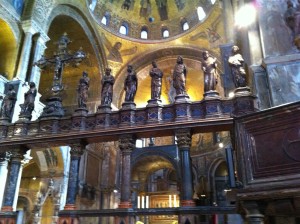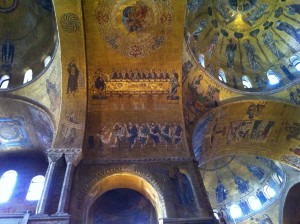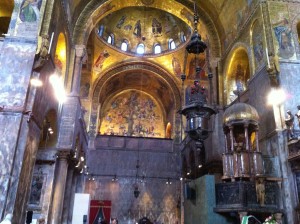I’m republishing this post as somehow it was removed from the internet today.
The Republic of Venice, the wealthiest piece of real estate in the world during its heyday, had a hearty appetite for entertainment and plenty of funds to feed it. Claudio Montiverdi, Andrea and Giovanni Gabrielli and, of course, Antonio Vivaldi, were the best known of the many composers who provided compositions for its dozens of churches and its several opera houses. With only a week in Venice, what to choose. Definitely Vivaldi. I ordered tickets online, but once we start wandering the city it is clear that there is music everywhere – nearly every church and museum is offering some sort of concert and they all sound amazing. Oh, well.
Saturday night and we set off to hear Vivaldi. I’m pretty sure I know where we’re going, but when we get to the entrance and show our tickets, it’s clear we’re in the wrong place – I’ve mistaken the Virtuosi di Venezia for the Sollisti di Venezia. Our casual strole turns into a forced march as we backtrack to St. Mark’s square looking for the Ateneo San Basso, a deconsecrated baroque church, now a concert hall. We make it just on time.
They called him Il Prete Roso – The Red Priest – for his flaming hair and beard. Excused from saying mass because of his asthma, Vivaldi worked instead teaching music to orphaned/abandoned girls attached to the Ospedale della Pieta, whose choir and orchestra he made famous. A virtuoso violinist himself, he wrote hundreds of cantatas, operas and other works, many lost, some still being discovered. Very influential in his day (J.S. Bach was a fan), his music went out of fashion and was rarely played until it was rediscovered in the 20th century.
Now, of course, we are waiting to hear the famous opening bars of the Four Seasons. The hall is packed, the acoustics wonderful. So are the musicians. The notes sparkle and dance. Pure Vivaldi – essence of Venice.
Sunday morning and 10:30 mass at St. Marco. We join a long line that starts to move slowly in through the main doors – and up a narrow winding stair. Only then do we realize our mistake – we’ve joined a line headed for a look at the famous 4 bronze horses on the cathedral roof – the horses the Venetians stole from Constantinople. We squeeze our way back down the stairs.
 We take seats in the transept as the mighty organ fills the enormous space. Claudio Montiverdi was choir master here and wrote music especially for St. Marco’s acoustics, placing choirs and groups of brass instruments around the cathedral balconies. We will content ourselves with the organ, the ‘Hossanahs’ of the choir we hear but do not see, and time to be in this space. I lift my eyes to a pensive St. John, head in hands,
We take seats in the transept as the mighty organ fills the enormous space. Claudio Montiverdi was choir master here and wrote music especially for St. Marco’s acoustics, placing choirs and groups of brass instruments around the cathedral balconies. We will content ourselves with the organ, the ‘Hossanahs’ of the choir we hear but do not see, and time to be in this space. I lift my eyes to a pensive St. John, head in hands,  thinking, thinking; a St. Luke at work writing Mary’s story; and hundreds of other mosaics – characters and scenes in jewel colors set in gold. A cathedral worthy of Venice at her most mighty, its aim – to impress – secular and sacred.
thinking, thinking; a St. Luke at work writing Mary’s story; and hundreds of other mosaics – characters and scenes in jewel colors set in gold. A cathedral worthy of Venice at her most mighty, its aim – to impress – secular and sacred.
[gdl_gallery title=”GALLERY_TITLE” width=”GALLERY_WIDTH” height=”IMAGE_HEIGHT” galid=”1″ ]




What sweet musical experiences!
They were, indeed, Stephen. And the best is yet to come!
I didn’t know you went to Mass at St. Marco. What a spectacular experience! Thanks for sharing.
Time to sit and absorb. Much the best way to experience this marvel.